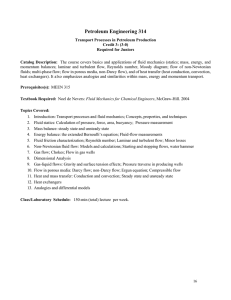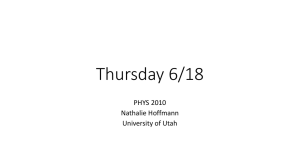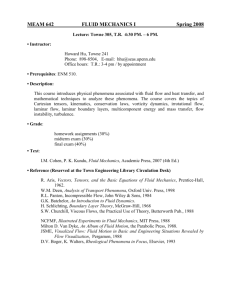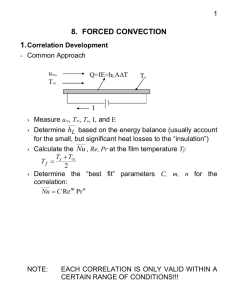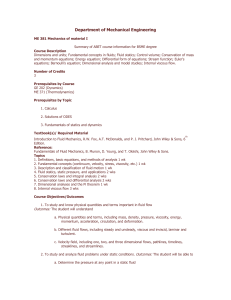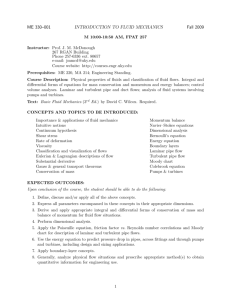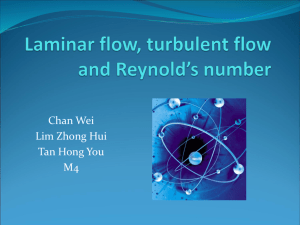ME 332 Outline
advertisement
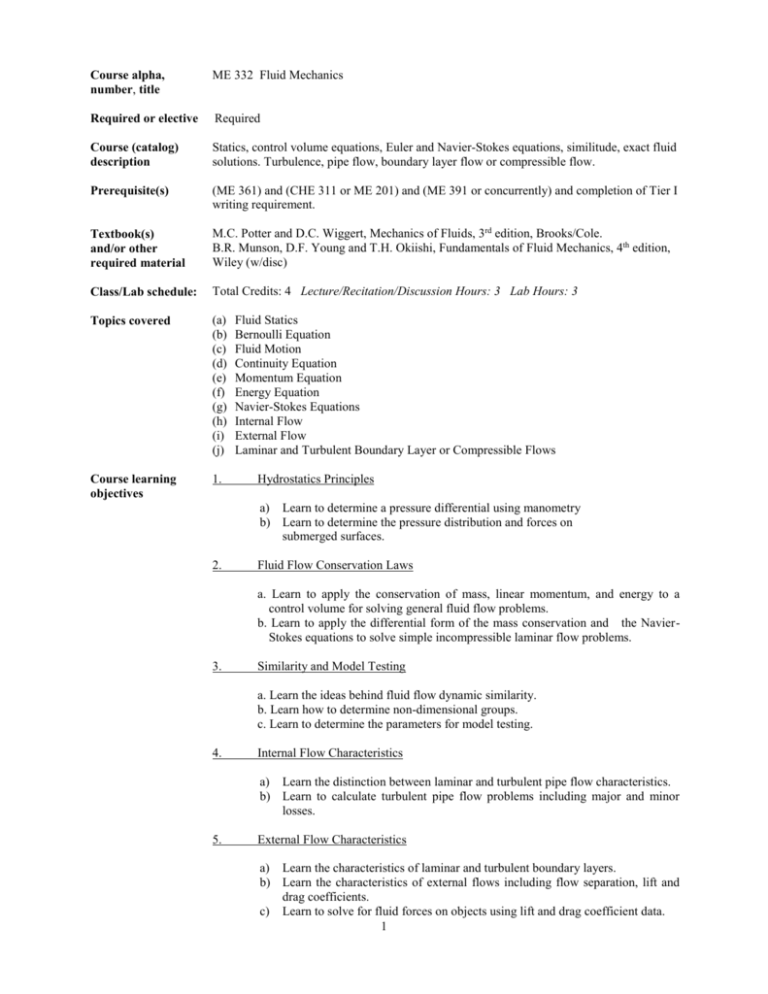
Course alpha, number, title ME 332 Fluid Mechanics Required or elective Required Course (catalog) description Statics, control volume equations, Euler and Navier-Stokes equations, similitude, exact fluid solutions. Turbulence, pipe flow, boundary layer flow or compressible flow. Prerequisite(s) (ME 361) and (CHE 311 or ME 201) and (ME 391 or concurrently) and completion of Tier I writing requirement. Textbook(s) and/or other required material M.C. Potter and D.C. Wiggert, Mechanics of Fluids, 3rd edition, Brooks/Cole. B.R. Munson, D.F. Young and T.H. Okiishi, Fundamentals of Fluid Mechanics, 4th edition, Wiley (w/disc) Class/Lab schedule: Total Credits: 4 Lecture/Recitation/Discussion Hours: 3 Lab Hours: 3 Topics covered (a) (b) (c) (d) (e) (f) (g) (h) (i) (j) Course learning objectives 1. Fluid Statics Bernoulli Equation Fluid Motion Continuity Equation Momentum Equation Energy Equation Navier-Stokes Equations Internal Flow External Flow Laminar and Turbulent Boundary Layer or Compressible Flows Hydrostatics Principles a) Learn to determine a pressure differential using manometry b) Learn to determine the pressure distribution and forces on submerged surfaces. 2. Fluid Flow Conservation Laws a. Learn to apply the conservation of mass, linear momentum, and energy to a control volume for solving general fluid flow problems. b. Learn to apply the differential form of the mass conservation and the NavierStokes equations to solve simple incompressible laminar flow problems. 3. Similarity and Model Testing a. Learn the ideas behind fluid flow dynamic similarity. b. Learn how to determine non-dimensional groups. c. Learn to determine the parameters for model testing. 4. Internal Flow Characteristics a) Learn the distinction between laminar and turbulent pipe flow characteristics. b) Learn to calculate turbulent pipe flow problems including major and minor losses. 5. External Flow Characteristics a) Learn the characteristics of laminar and turbulent boundary layers. b) Learn the characteristics of external flows including flow separation, lift and drag coefficients. c) Learn to solve for fluid forces on objects using lift and drag coefficient data. 1 6. Laboratory Measurements a) b) c) d) e) 1. Learn the use of flow visualization, pressure transducers, Pitot tubes, and hotwire anemometry. Participate in computer data acquisition. Demonstrate basic fluid mechanics principles including hydrostatics, conservation of mass, momentum and energy, pressure variation along and normal to streamlines, laminar and turbulent flows. Participate in team building experiences through working in groups and a final group project. Communicate experimental results with written reports and a final project oral presentation. Organize the final project including the experimental methodology, setup, project timeline, data processing, and project result presentation (written and oral). Relationship of course to ME program outcomes The following measurement standard is used to evaluate the relationship between the course outcomes and the educational-program outcomes: 3 = Strong Emphasis, 2 = Some Emphasis, 1 = Little or No Emphasis. (a) an ability to apply knowledge of mathematics, science, and engineering—3 (b) an ability to design and conduct experiments, as well as to analyze and interpret data—2 (c) an ability to design a system, component, or process to meet desired needs—1 (d) an ability to function on multi-disciplinary teams—3 (e) an ability to identify, formulate, and solve engineering problems—2 (f) an understanding of professional and ethical responsibility—1 (g) an ability to communicate effectively—3 (h) the broad education necessary to understand the impact of engineering solutions in a global/societal context—1 (i) a recognition of the need for and the ability to engage in life-long learning—1 (j) a knowledge of contemporary issues—1 (k) an ability to use the techniques, skills, and modern engineering tools necessary for engineering practice—3 (l) design, build, and test in mechanical systems area—1 (m) design, build, and test in thermal/fluids area—2 (n) application of advanced mathematics—2 (o) capstone design experience—1 Contribution to professional component: 100% Engineering Science 0% Engineering Design Person(s) who prepared this description John Foss and Z.J. Wang for lecture, Ahmed Naguib for lab. Date of Preparation 2
